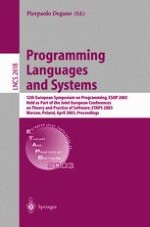2003 | Buch
Programming Languages and Systems
12th European Symposium on Programming, ESOP 2003 Held as Part of the Joint European Conferences on Theory and Practice of Software, ETAPS 2003 Warsaw, Poland, April 7–11, 2003 Proceedings
herausgegeben von: Pierpaolo Degano
Verlag: Springer Berlin Heidelberg
Buchreihe : Lecture Notes in Computer Science
Enthalten in: Professional Book Archive
